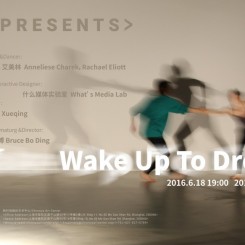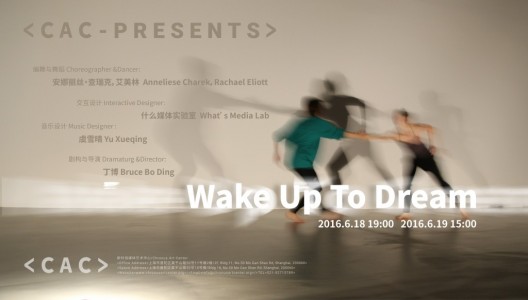Time
2016.06.18 19:00
2016.06.19 15:00
Venue
Chronus Art Center (Building 18, No 50 Moganshan Road, Shanghai)
Crew
Choreographer &Dancer: Anneliese Charek, Rachael Eliott
Interactive Designer: What’s Media Lab
Music Designer : Yu Xueqing
Dramaturge &Director: Bruce Bo Ding
Organizer
Chronus Art Center
(Free admission, but there are only limited seats so reservation is required. Please sign up here: http://form.mikecrm.com/b25FDx)
Description
Everything you can imagine is real. – Pablo Picasso
Technology has always been influencing the form and intensity of our experience while at the same time changing our imagination of the future. Such imagination includes a sort of high-spirited progressivism but also implies an ambivalence which could be partly attributed to the re-understanding of reality: from photoshoped selfies to AI lover, from social personas to virtual identities, we have re-shaped reality and our relationship with it. When information loses its body and action is modulated by technologies, “virtual” has reclaimed its original meaning, that is the potential or force to develop into actual existence.
This work is a performative response to the current situation and a rehearsal of possible relations between the live modes of existence and generative representation. When sound, image, body and program are all “performers” and “agents” on the stage, what we want to create is a real dream.
And when we wake up, are we not facing nothing but another dream?
About Mediated Body and Embodied Technologies
“Mediated Body and Embodied Technologies (M.B.E.T.)” is an open-source practice repository and research process addressing the various mechanisms and possibilities of human future mediated by technologies. Started by reflecting and speculating on the relations between the enacted and the represented as well as the virtual and the real (a contingent production rather than a natural inevitability), M.B.E.T. brings back embodiment into the picture to investigate if/how the forms/media of embodiment are relevant in the production of identity and subjectivity as well as the circulation and communication of information. In the spirit of open source, it tries to create a fluid and evolving space in which practitioners and researchers from different areas can come together and contribute in this creative exploration.

